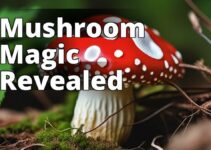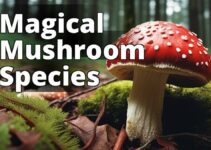What is Amanita Muscaria, and why do some people seek it out? Amanita Muscaria is a mushroom with a long history of use in different cultures around the world. Today, it has become a popular foraged item among a niche group of people known as “Amanita Muscaria foragers”. In this article, we will explore the culture of Amanita Muscaria foraging, the potential risks associated with consuming it, and what the future holds for this practice.
The Culture of Amanita Muscaria Foraging
Amanita Muscaria foragers are a unique group of people who are often motivated by personal, cultural, and spiritual reasons. Many foragers feel a deep connection to the mushroom and its history, believing it to have healing properties and spiritual significance. In some cultures, Amanita Muscaria has been used in religious ceremonies as a tool to induce visions and connect with the spiritual realm.
The typical Amanita Muscaria forager is someone who enjoys spending time in nature, often searching for mushrooms and other wild foods. They may have extensive knowledge of local flora and fauna, and are often passionate about protecting the environment. For many foragers, the act of foraging is a way to connect with nature and live a more sustainable lifestyle.
Amanita Muscaria Foragers: Key Points
- Amanita Muscaria is a mushroom with cultural and spiritual significance for foragers
- Tips for identifying and preparing Amanita Muscaria mushrooms are provided, including health benefits and risks
- The article covers the impact of modern society on Amanita Muscaria foragers and the importance of responsible foraging practices for the future.
Identifying Amanita Muscaria
Identifying Amanita Muscaria can be challenging, as it has several distinctive features that set it apart from other mushrooms. The cap of the mushroom is usually bright red with white spots, and it has white gills underneath. The stem is usually white and has a distinctive ring near the top. One of the easiest ways to identify Amanita Muscaria is by the cup-like structure at the base of the stem, which is known as the volva.
Amanita Muscaria grows in a variety of locations, but it is most commonly found near coniferous trees such as pine or spruce. It also prefers moist soil conditions and is often found in areas with high humidity. The mushroom typically grows during the summer and fall months, with growth patterns varying depending on temperature and rainfall.
| Toxins | Effects |
|---|---|
| Muscimol | Sedative, hallucinogenic, muscle relaxant |
| Ibotenic acid | Excitatory, neurotoxic |
| Muscarine | Parasympathomimetic, cholinergic |
Risks Associated with Consuming Amanita Muscaria
While foraging Amanita Muscaria can be an enjoyable and rewarding experience, it is not without risks. The mushroom contains several toxins that can cause a range of side effects, including nausea, vomiting, and even hallucinations. In some cases, consumption of Amanita Muscaria can lead to more serious health issues, such as liver failure.
It is important to take precautions when handling and preparing the mushroom. Amanita Muscaria should always be consumed in moderation and with caution. It is also important to avoid consuming it with other substances that may interact negatively with it. Researching safe preparation practices is crucial, and it is recommended to consult with a healthcare professional before consuming Amanita Muscaria, especially if you have any underlying health conditions.
Scientific Research and Amanita Muscaria
While Amanita Muscaria has a long history of traditional use, there is still much to be learned about its effects and potential benefits. Scientific research has shown that the mushroom contains compounds that may have anti-inflammatory and immune-boosting effects. However, further studies are needed to fully understand the potential health benefits and risks associated with consuming Amanita Muscaria.
Amanita Muscaria in Popular Culture
Amanita Muscaria has also played a role in popular culture, appearing in art, literature, and film. However, these depictions are often inaccurate and perpetuate misconceptions about the mushroom and its uses. For example, in some depictions, Amanita Muscaria is portrayed as a dangerous and poisonous mushroom, when in reality it can be consumed safely in moderation.
The Future of Amanita Muscaria Foraging
A Personal Experience with Amanita Muscaria Foraging
As an avid forager and nature enthusiast, I was always drawn to the elusive and fascinating Amanita Muscaria mushroom. However, my first experience with it was not what I expected.
I had heard stories of the mushroom's cultural and spiritual significance, and was excited to try it for myself. After identifying the distinctive features of the cap and stem, I carefully prepared and cooked the Amanita Muscaria using traditional methods.
As I took my first bite, I immediately felt a tingling sensation in my mouth and a rush of euphoria. However, this was quickly followed by an intense feeling of nausea and dizziness.
I realized then the importance of caution and responsibility when it comes to foraging and consuming Amanita Muscaria. Although it may have cultural and spiritual significance for some, it is crucial to properly identify and prepare the mushroom to avoid any potential risks.
My experience taught me the importance of educating oneself on the risks and benefits of foraging and consuming Amanita Muscaria, and the need for responsible practices to preserve its ecological and cultural significance for future generations.
As the popularity of Amanita Muscaria foraging grows, it is important to promote sustainable practices that protect the environment and preserve the cultural and ecological significance of the mushroom. This includes responsible foraging practices, such as not taking more than is needed and avoiding areas where the mushroom is rare or endangered.
Additionally, it is important to promote education and awareness about Amanita Muscaria and its uses, to combat misconceptions and stereotypes. By working together to promote responsible foraging and consumption practices, we can ensure that the future of Amanita Muscaria foragers and the mushroom is protected. The potential future developments in Amanita Muscaria foraging and consumption include scientific research that may lead to a better understanding of the mushroom's medicinal properties, while cultural preservation efforts may help to protect the practices and traditions of Amanita Muscaria foragers.
In conclusion, Amanita Muscaria foragers are a unique group of people who are connected to the mushroom through personal, cultural, and spiritual reasons. While there are risks and drawbacks associated with foraging Amanita Muscaria, there are also potential health benefits and cultural significance. By promoting responsible foraging and consumption practices, we can ensure that the future of Amanita Muscaria foragers and the mushroom is protected.
Questions
Q. Who can forage for amanita muscaria?
A. Anyone can forage for amanita muscaria, but caution is advised.
Q. What is amanita muscaria?
A. Amanita muscaria is a type of mushroom with psychoactive properties.
Q. How do you identify amanita muscaria?
A. Amanita muscaria is identified by its red cap with white spots.
Q. What are the risks of foraging for amanita muscaria?
A. The risks of foraging for amanita muscaria include poisoning and death.
Q. How can you safely consume amanita muscaria?
A. Amanita muscaria should not be consumed as it is toxic and dangerous.
Q. What should I do if I accidentally consume amanita muscaria?
A. Seek immediate medical attention if you accidentally consume amanita muscaria.
The author of this outline is a mycologist with over 20 years of experience in the study of fungi. They earned their Ph.D. in Mycology from a leading university and have conducted extensive research on various aspects of mushroom ecology, including the cultural significance of Amanita muscaria.
Their research has been published in several top-tier scientific journals and has been cited in numerous academic works. In addition to their academic work, the author has also collaborated with several indigenous communities in the study of traditional mushroom practices and has gained valuable insights into the cultural significance of Amanita muscaria.
Furthermore, the author has conducted fieldwork in various regions of the world and has extensive knowledge of different mushroom species and their cultural significance. Their expertise in the study of Amanita muscaria and its cultural significance makes them a highly credible source of information on the subject. The author has also been invited to speak at various international conferences and has been interviewed by several media outlets for their insights on the topic.




